Geoscience Reference
In-Depth Information
ultimately cause the waves to break. This is an important
mixing and dissipation mechanism for heat and energy in
the oceans (Section 6.4.4).
shear. These vortices are important mixing mechanisms in
nature; they are called
Kelvin-Helmholtz waves
.
4.9.7
The tide: A very long period wave
4.9.6 Waves at shearing interfaces -
Kelvin-Helmholtz instabilities
The tide, a shallow-water wave of great speed
(20-200 ms
1
) and long wavelength, causes the regular
rise and fall of sea level visible around coastlines. Newton
was the first to explain tides from the gravitational forces
acting on the ocean due to the Moon and Sun (Figs
4.49-4.52). Important effects arise when the Sun and
Moon act together on the oceans to raise extremely high
tides (spring tides) and act in opposition on the oceans to
raise extremely low tides (neap tides) in a two-weekly
rhythm. It has become conventional to describe tidal
ranges according to whether they are macrotidal (range
Stratified fluid layers (Section 4.4) may be forced to shear
over or past one another (Fig. 4.48). Such contrasting
flows commonly occur at mixing layers where water masses
converge; fine examples occur in estuaries or when river
tributaries join. On a larger scale they occur along the mar-
gins of ocean currents like the Gulf Stream (see Section 6.4).
In such cases an initially plane
shear layer
becomes unsta-
ble if some undulation or irregularity appears along the
layer, for any acceleration of flow causes a pressure drop
(from Bernoulli's theorem) and an accentuation of the dis-
turbance (Fig. 4.48). Very soon a striking, more-or-less
regular, system of asymmetrical vortices appears, rotating
about approximately stationary axes parallel to the plane of
4 m), mesotidal (range 2-4 m), or microtidal (range
2 m), but it should be borne in mind that tidal
range always varies very considerably with location in any
one tidal system.
An observer fixed with respect to the Earth would
expect to see the equilibrium tidal wave advance progres-
sively from east to west. In fact, the tides evolve on a rotat-
ing ocean whose water depth and shape are highly variable
with latitude and longitude. The result is that discrete
rotary and standing waves dominate the oceanic tides and
their equivalents on the continental shelf (see Section 6.6).
In detail the nature of the tidal oscillation depends criti-
cally on the natural periods of oscillation of the particular
ocean basin. For example, the Atlantic has 12-h tide-
forming forces while the Gulf of Mexico has 24 h. The
Pacific does not oscillate so regularly and has mixed tides.
Advance of the tidal wave in estuaries that narrow
upstream is accompanied by shortening parallel to the crest,
crestal amplification, and steepening of the tidal wave whose
ultimate form is that of a
bore
, a form of solitary wave. In a
closed tidal basin a
standing wave
of characteristic resonant
period,
T
, with a node of no displacement in the middle and
antinodes of maximum displacement at the ends, has a
Atmosphere
r
1
Warm/fresh upper water layer
h
1
h
H
l
Waves may
break and
mix
r
2
Cool/saline lower layer
Wave motions propagating down
h
2
Wave motions propagating up from depth
Fig. 4.47
Internal waves at a sharp density interface.
Initial configuration
Intermediate
−
−
+
+
+
−
−
Fig. 4.48
Kelvin-Helmholtz waves formed at a sharp, shearing interface between clear up-tank moving less dense fluid and dark downtank-
moving denser fluid. Note shape of waves, asymmetric upflow. Pressure deviations from Bernoulli accelerations amplify any initial disturbances
into regular vortices.













Search WWH ::

Custom Search